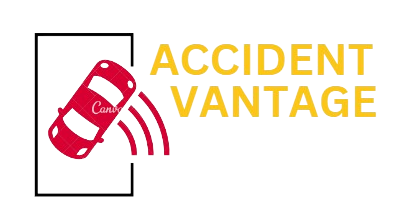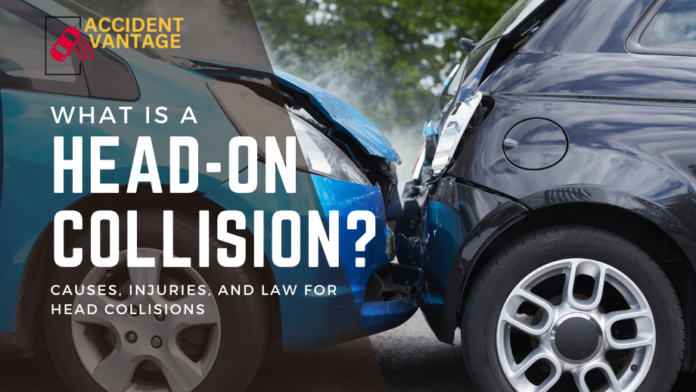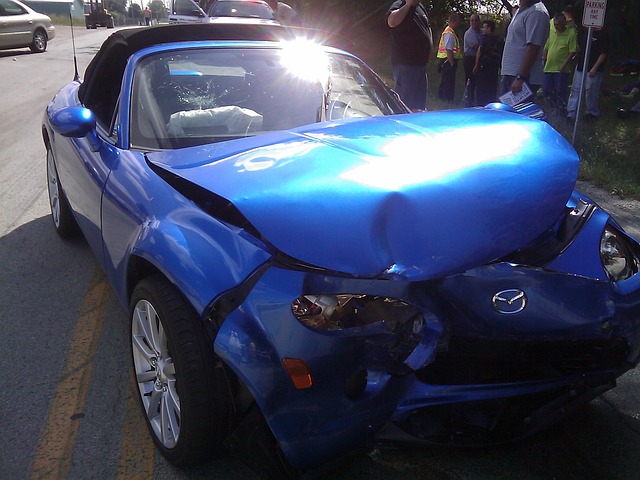Within the complex web of vehicular accidents, we come face to face with a term that commands attention like a flashing red light – the head-on collision. This isn’t just another bump on the road; it’s a collision that demands attention, a direct clash of forces that can alter lives in a fraction of a second.
When we talk about the odds, it’s a shocker: head-on, rollover, pedestrian, and bicycle crashes together play a mere 6.1% role in the grand events of accidents. Yet, they command attention with a bone-chilling 34.5% of traffic-related deaths. This isn’t just about the US; it’s a worldwide symphony of risk that’s echoing on every road.
A mere 2% of all US crashes are head on collisions, but they pack a disproportionate punch. They stand tall at 10.1% of the nation’s fatal crashes, speaking volumes about their lethal potential. According to the Insurance Information Institute, 2020 witnessed these collisions claiming over 3,600 lives, with injuries beyond count – a stark reminder of the brutal reality behind these numbers.
This isn’t just a discourse with disaster; it’s a confrontation that can alter lives in an instant. In this article, we’ll explore what is a head on collision, the causes that set the stage for head-on collisions, the haunting injuries that head collisions leave behind, and the legal script that unfolds when tragedy takes the wheel. So, brace yourself for insights that could reshape how you look at the road.

What is a Head-On Collision? The Basics You Need to Know
Commonly known as a “frontal crash” or “front impact accident,” a head-on collision unfolds when two vehicles, hurtling from opposite directions, collide headfirst. The outcome? A discord of crumpling metal, shattering glass, and the abrupt cessation of motion.
Head collision is the ultimate showdown, where two vehicles on a collision course make an unapologetic frontal connection. Picture it: a symphony of screeching tires, twisting metal, and the sudden halt of momentum – that’s the impact of a head-on collision.
Head-On Collision isn’t Just A Regular Bump on the Road
Unlike other types of collisions that might leave damages in isolated pockets, a head-on collision distributes its impact across the front ends of both vehicles. The extent of the wreckage often correlates with the speed at which the vehicles were traveling at the point of impact – a dynamic exchange of physics that spares no room for subtlety.
Moreover, a head-on collision can materialize when a vehicle crashes directly into an immovable object, like a telephone pole or concrete barrier. The result? A potent release of energy leading to crumpled hoods triggered airbags and the potential for grave injuries.
This type of collision commands attention due to the sheer force it wields. While modern vehicle designs strive to mitigate impact and safeguard occupants, a head-on collision remains one of the most formidable scenarios on the road. It’s a stark reminder that no matter the advancements, the laws of physics hold their sway.
Read more: Pain and Suffering Calculator: Discover the True Cost of Your Misery!

The Culprits Behind the Head Collision
When two vehicles collide head-on, the result is more than just a mechanical intersection. It’s a nexus of choices, circumstances, and actions culminating in a fateful encounter. Among the many possibilities of head on crashes, one of the most prevalent triggers is a driver venturing into the opposite lane – a disaster that can take shape due to various circumstances.
14 Causes of Head-On Collision Car Accidents
In the unpredictable world of road accidents, one type of collision stands out with a chilling and dramatic impact – the head-on collision car accident. While capable of occurring anywhere, these collisions tend to find their tragic stage on rural roads.
It’s here that factors like narrow lanes, insufficient lighting, and the absence of guardrails or traffic dividers conspire to create a perfect storm. Yet, whether it’s the heart of a bustling metropolis or the tranquility of the countryside, head-on collision car accidents don’t discriminate. They’re the unwelcome guests that crash the party when least expected, and they make their presence felt in ways that linger long after the debris is cleared.
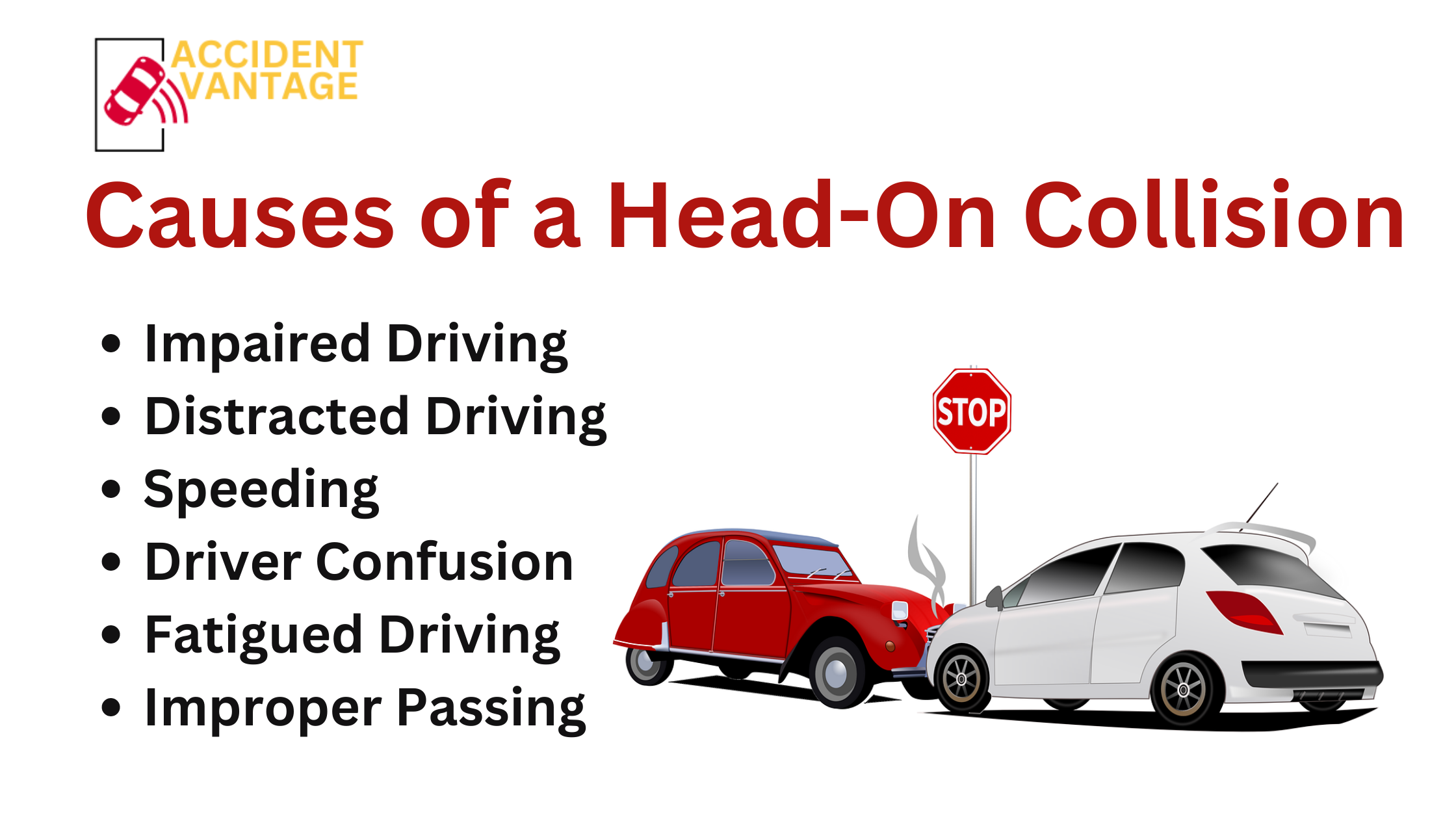
Common Causes of Head-On Collision Car Accidents
Here are some of the common causes of head-on collision car accidents:
1. Impaired Driving
The reckless gamble of impaired driving continues to cast a shadow over road safety. Drivers who choose to get behind the wheel after consuming alcohol, drugs, or prescription medication place themselves and others at grave risk. The influence of these substances significantly diminishes a driver’s reaction time and judgment.
This often results in an alarming scenario where motorists find themselves heading in the wrong direction, oblivious to the impending danger until it’s too late. Impaired driving remains a recurrent cause of head on crashes, leaving behind shattered lives and harrowing consequences that resonate long after the collision.
2. Distracted Driving
Distracted driving has emerged as a silent menace on our roads, often being the catalyst behind heart-wrenching head-on collisions. With the prevalence of modern technology, the alarming rise in crashes caused by cell phone usage has become evident. Texting while driving – a seemingly innocent act – has proven to be not only risky but also illegal in 48 states.
Yet, the dangers extend beyond texting. Activities such as loud music, adjusting controls, eating, and engaging in conversations with passengers divert a driver’s focus, turning their vehicle into a potentially deadly projectile. Inattentiveness can lead cars astray, causing them to veer across the centerline and into oncoming traffic.
3. Speeding: Breaking Limits, Breaking Lives
The pervasive nature of speeding endangers lives on a daily basis. Drivers who exceed posted speed limits or flop to adjust their speed to road conditions heighten the risk of losing control. Such recklessness culminates in skidding into opposing lanes, creating a collision trajectory that is almost impossible to escape. The force generated by high-speed head-on collisions invariably leads to catastrophic, often fatal injuries, perpetuating the grim toll of speeding.
4. Driver Confusion
Navigational confusion – often triggered by unfamiliar roads or misunderstood signs – plays a more significant role in head-on collisions than one might assume. A driver’s momentary lapse in understanding can lead to disastrous consequences.
From traversing one-way streets in the wrong direction to aging drivers grappling with night-time visibility issues, confusion can quickly escalate into a life-threatening situation. Whether due to a lack of clarity in road design or the limitations of human perception, these instances spotlight the critical need for better road education and signage.
5. Fatigued Driving
The risks of driving while fatigued cannot be overstated. The parallel between fatigued driving and its impaired counterpart is chilling. Operating a vehicle while sleep-deprived yields similar effects to driving under the influence.
The scenarios are dishearteningly familiar: drivers who have not had adequate rest, those who have endured extended shifts, or those who have been on the road for prolonged durations can easily lose control. A common tragedy unfolds as vehicles drift into oncoming traffic, with the potential for instantaneous accidents. It is in these blink-of-an-eye moments that lives are forever altered.
6. Improper Passing: Impatience Leading to Tragedy
Impatient drivers, often fueled by the desire to overtake slower-moving vehicles, inadvertently become architects of tragedy. Particularly prevalent on two-lane highways, this impatience prompts risky decisions, such as passing on double yellow lines.
This reckless maneuver disregards the inherent dangers of entering oncoming traffic lanes. The collision’s aftermath is a stark reminder that even legal passing can swiftly turn fatal when recklessness guides the wheel.
Other Causes of Head-On Collisions
Here are some other causes of head on crashes:
7. Drunk Driving
Among the gravest of all causes, drunk driving embodies a dangerous concoction of impaired judgment and compromised coordination. Operating any automobile under the influence of alcohol or drugs significantly impairs a driver’s ability to navigate the road safely. This impairment extends to recognizing signs, reacting to situations, and maintaining vehicle control.
The consequences are often dire, leading to wrong-way driving, where drivers unknowingly enter opposing lanes, setting the stage for head collisions. It’s a stark reminder that indulging in substances while behind the wheel is an act that puts lives on the line.
8. Defective or Dangerous Roads
While drivers often bear the brunt of responsibility, the roads they traverse can also play a pivotal role in head-on collisions. Poorly designed or inadequately maintained roads can present unsuspecting drivers with hazardous conditions.
Uneven surfaces, inadequate signage, or sudden road irregularities can catch drivers off guard, triggering them to lose control and veer into opposing lanes. These car accidents emphasize the importance of road infrastructure and maintenance in ensuring the safety of all road users.
9. The Modern-Day Distraction
With the dawn of advanced technology, distracted driving has become an alarming concern. Texting, though particularly notorious, is not the sole distraction. Activities such as answering calls, engaging with in-car entertainment systems, or even glancing at navigation devices can divert attention from the road.
These distractions have a cumulative effect, causing drivers to drift into oncoming lanes with potentially devastating consequences. In an era of constant connectivity, raising awareness about the hazards of distracted driving is paramount.
10. Poor Weather Conditions: Rain, Fog, and Diminished Visibility
Nature’s unpredictability poses a unique set of challenges on the road. Rain, fog, and other adverse weather conditions compromise visibility and traction. Rain-slicked roads, reduced visibility due to fog, or even glare from the sun can lead to drivers inadvertently crossing into oncoming traffic.
These situations highlight the need for heightened caution and adjusting driving behaviors to match the changing weather conditions.
11. Drowsy Driving
Behind the wheel, fatigue can be as debilitating as intoxication. Drowsy driving, often overlooked, can result from inadequate sleep, long hours on the road, or strenuous work shifts. The outcome is similar to that of drunk or distracted driving – impaired reaction times and diminished situational awareness. Fatigue-induced drifting into opposing lanes can precipitate head-on collisions, underscoring the critical role of rested and alert driving.
12. Driving the Wrong Way Down a Road: A Fatal Misstep
In moments of confusion or inattention, drivers can find themselves traveling against the traffic flow. Wrong-way driving, often resulting from misreading signs or misunderstanding road configurations, is a grave hazard.
These scenarios can set the stage for head collisions as unsuspecting drivers meet vehicles approaching at high speeds. Vigilance, adherence to road signage, and a clear understanding of the road’s layout are crucial in preventing such catastrophic errors.
13. Hazardous Construction Zones
Construction zones, though temporary, introduce a unique set of hazards. Reduced lanes, sudden shifts in traffic flow, and altered road conditions can confuse drivers, leading to sudden lane changes or crossing into opposing lanes.
The presence of construction equipment and workers further compounds the risks. Navigating construction zones demands heightened attention and adherence to reduced speed limits, preventing collisions that can have far-reaching consequences.
14. Senior Drivers
Aging brings wisdom but can also usher in challenges on the road. Senior drivers – while often experienced – may grapple with diminished reflexes, visual impairments, and cognitive decline. Night-time driving, in particular, can pose challenges due to reduced visibility.
These factors, combined with unfamiliarity with modern road systems, increase the potential for wrong-way driving and head on collisions. Initiatives that cater to senior drivers’ needs and promote awareness are crucial to ensuring their safety and the safety of others.
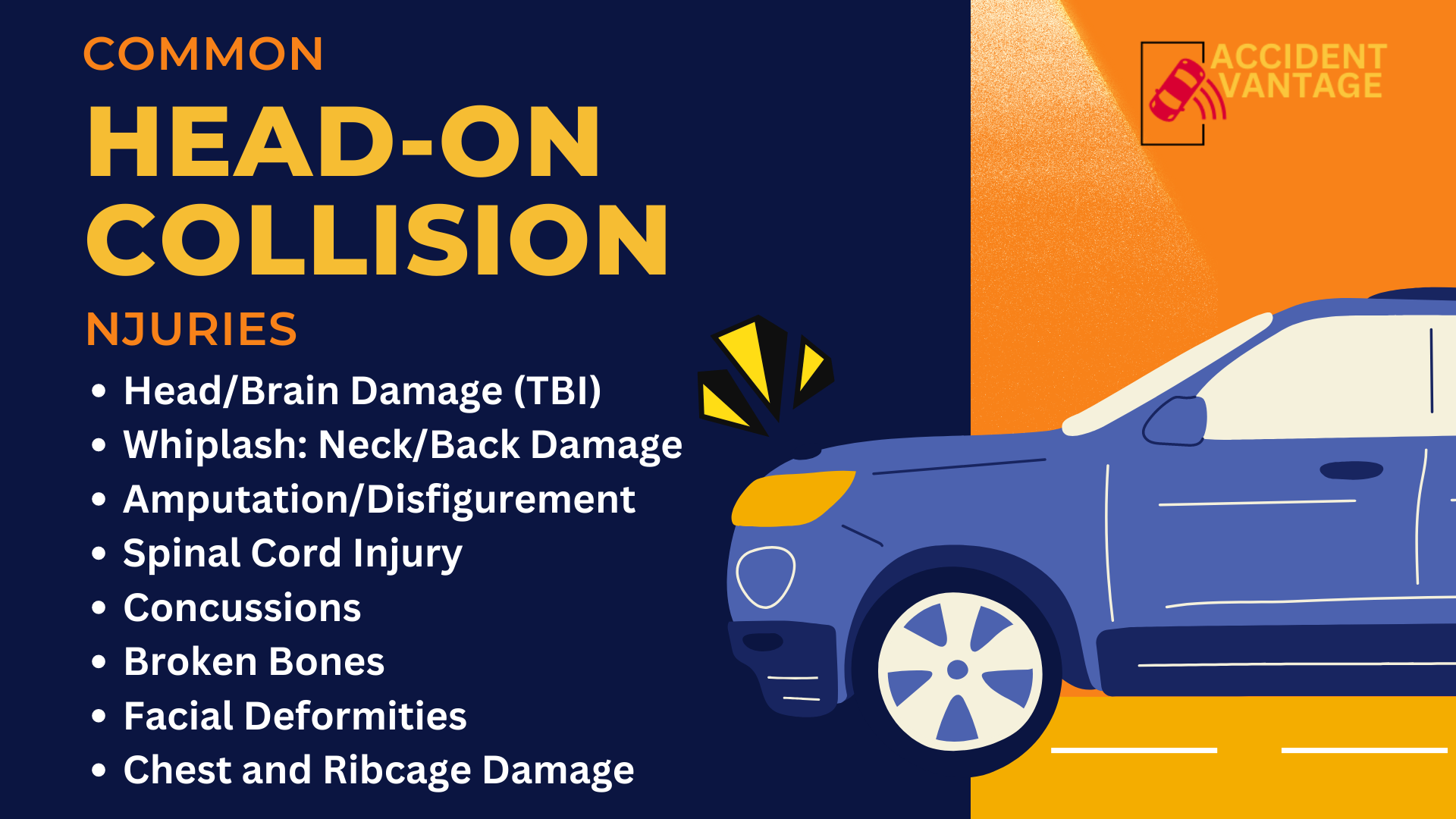
Common Head-On Collision Injuries
In the aftermath of a head on collision, even with seatbelts buckled, the toll of injuries can be nothing short of catastrophic. These collisions unleash devastation, leaving victims grappling with severe injuries. Let’s delve into the common injuries that often emerge from the wreckage of a head on collision.
1. Head/Brain Damage (TBI)
The force of impact can thrust heads into steering wheels, dashboards, or even side windows, causing traumatic brain injuries (TBIs). These injuries transcend the physical, altering lives in profound ways. Memory lapses, cognitive impairment, and emotional struggles are some of the harrowing consequences that can follow a TBI.
2. Whiplash: Neck/Back Damage
Whiplash, that seemingly innocuous term, masks the searing pain that can follow a head collision. The rapid back-and-forth motion can wreak havoc on the delicate structures of the neck & spine, causing long-lasting discomfort and limiting mobility.
Its stealthy nature means that victims might not fully realize the extent of their suffering until days or even weeks later. The neck’s delicate structures, subjected to abrupt and violent motion, can result in a prolonged recovery journey marked by discomfort and restriction.
3. Amputation/Disfigurement: A Life Altered
The crushing force of a head-on crash can lead to amputation or severe disfigurement, thrusting victims into a world forever changed. The loss of a limb or the alteration of one’s appearance can entail not just physical pain but a profound emotional toll as well.
4. Spinal Cord Injury
When a head on collision strikes, the spine often bears the brunt of the impact, causing spinal cord injuries that are likely to shatter lives. The consequences can be profound, ranging from partial paralysis to permanent disability.
The implications ripple through every facet of a survivor’s existence, affecting mobility, independence, and even emotional well-being. As victims grapple with the monumental challenges of spinal cord injuries, the path to recovery becomes complex and arduous.
5. Concussions
A collision doesn’t always manifest its toll immediately. Concussions – silent but potent – can cast victims into a world of disorientation, headaches, and cognitive struggles. The insidious nature of concussions underscores the importance of comprehensive medical evaluation after any collision.
Read more: Rachel Stone Car Accident: Mourning the Loss of a Beloved Lee’s Summit School Teacher
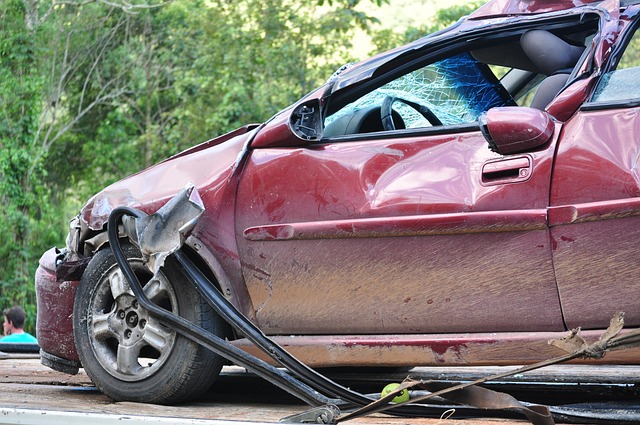
6. Broken Bones
Bones – meant to provide structure and strength – can turn into brittle victims of a head collision. The sheer force of impact can lead to fractures, requiring intricate medical intervention and often lengthy rehabilitation.
7. Facial Deformities
The ravages of a head on collision extend beyond the body, often leaving victims with facial deformities that transcend physical pain. Facial injuries can reshape not just appearances but also self-esteem and emotional well-being.
The trauma of facing an altered reflection in the mirror can be as profound as the physical pain, making facial reconstruction surgeries not just about restoring aesthetics but about reclaiming a sense of self.
8. Lacerations: The Visible Scars
Shattered glass and twisted metal – these are the ingredients of lacerations, the visible scars borne by collision survivors. Beyond the physical pain, these wounds often leave emotional imprints that linger.
9. Internal Bleedings
Internal injuries – concealed beneath the surface – can lead to internal bleeding that goes unnoticed until it’s too late. The aftermath of a collision can thus become a race against time, with medical intervention as the only hope.
10. Organ Damage
The ferocity of a head collision can disrupt the intricate balance of organs within the body. Injured organs not only cause immediate pain but can also set off a cascade of health challenges that require expert medical attention.
11. Abdominal Bruising
Bruises tell tales of impact, but abdominal bruising can often mask deeper injuries that demand medical attention. The body’s core, vital and fragile, can be subject to unseen trauma in a head collision.
12. Chest and Ribcage Damage: Collateral Impact
While airbags and seatbelts aim to save lives, their deployment can also lead to chest and ribcage injuries. The very devices meant to protect can, in the chaos of collision, inadvertently cause harm.
13. Crushed Legs and Feet: A Painful Reality
The lower extremities, exposed and vulnerable, can bear the brunt of the collision’s impact. Crushed legs and feet create not just physical pain but a myriad of challenges in regaining mobility and independence.
14. Burns
The collision’s fiery aftermath can subject victims to the excruciating agony of burns. These injuries, reaching beyond the physical realm, sear into the very core of survivors’ lives. The challenges are myriad – from excruciating pain and the necessity for intricate medical care to the long road of recovery and potential scarring. Burns become a testament to the collateral damage inflicted by a head collision, casting a shadow that lingers long after extinguishing flames.
Read more: Split Face Diving Accident: Take Your Step to Avoid Such Tragic Incidents
Law for Head Collision Car Accidents
When the dust settles after a head on collision, the legal landscape comes into focus, illuminating the path toward justice and accountability. Navigating the aftermath of such a harrowing event demands a deep understanding of the laws that govern these head-on collision accidents.
So, let’s delve into the legal terrain that unfolds after a head collision.
Determining Fault for the Head Collision
The pivotal question echoes through courtrooms and negotiations alike: who is at fault? In head on collisions, pinpointing responsibility requires a meticulous examination of the evidence. Skid marks, vehicle positions, witness accounts – these pieces form a complex puzzle that legal experts piece together to unveil the truth. Establishing fault isn’t just about assigning blame; it’s about ensuring justice prevails.
Comparative Negligence: The Grey Area
The legal arena isn’t always black and white. Sometimes, multiple parties share a portion of the blame. That’s where comparative negligence enters the fray. This legal principle acknowledges that sometimes, even the injured party may have contributed to the collision.
The outcome? Compensation adjustments that reflect the level of responsibility each party holds. It’s a reminder that shades of grey often blur liability lines in accidents.
Seatbelt Laws: Strapping in for Safety
The importance of seatbelts cannot be overstated. The law, echoing the same sentiment, mandates their use for both drivers and passengers. But what if a car accident occurs and a seatbelt wasn’t fastened? That’s where contributory negligence plays a role.
In some states, failure to buckle up can impact compensation claims. It’s a stark reminder that safety measures, both in law and on the road, bear weighty consequences.
Statute of Limitations: Racing Against Time
Time waits for no one, and the law concurs. The statute of limitations sets a ticking clock for pursuing legal action after a head on collision. Waiting too long can extinguish the right to seek compensation. While the timeframe varies by jurisdiction and circumstances, the message remains clear: prompt action is key.
Insurance Battles: The Claims Journey
Insurance, often the safety net in the aftermath of a car accident, can become its own battleground. Navigating insurance claims requires an understanding of policy terms, negotiation skills, and sometimes, even legal recourse. Uninsured and underinsured motorist coverage, familiar terms in the insurance realm, can be a lifeline when the other party lacks adequate coverage. It’s a reminder that while insurance is meant to ease the burden, the path to fair compensation can be paved with complexities.
Head-On Car Accident Lawyer: The Legal Representation
In the aftermath of a head collision, legal representation or a head-on car accident lawyer can become a hopeful beacon. Attorneys who specialize in personal injury law become advocates for justice, helping victims traverse the intricate legal maze. Their expertise in negotiating settlements or litigating in court can make the difference between a fair resolution and an uphill battle.
Closing Thoughts: Forging a Safer Path
In wrapping up our journey through the complexities of head on collisions, we’re reminded that these incidents bear far-reaching consequences. From their triggers to the injuries they inflict, and the legal maze that follows, our exploration underscores the need for heightened awareness.
By embracing responsible driving practices, advocating for change, and seeking expert guidance in times of crisis, we can collectively shape a future where the specter of head on collisions is diminished and our roads become safer passages for all.
Frequently Asked Questions – FAQs
1. What happens if you hit your head in a car accident?
In the unfortunate event of a car accident, the impact can lead to a range of head injuries that vary in severity:
- Contusions, often referred to as brain bruises, can occur due to the brain hitting the inside of the skull upon impact.
- Skull fractures can result from the force of the collision, leading to cracks or breaks in the skull bone.
- Intracranial hemorrhages (ICH) involve the rupture of blood vessels within the brain, leading to bleeding inside the cranial cavity.
- Diffuse axonal injuries (DAI) arise when the brain rapidly shifts inside the skull during the accident, causing widespread damage to nerve cells and their connections.
2. How much force is in a head-on collision?
Understanding the forces at play in a head-on collision can provide insight into the severity of such impacts. Imagine two cars traveling at 25 m.p.h. colliding head-on. The force generated is equivalent to a 50 m.p.h. head-on collision due to the combined speed. On an interstate where both cars are traveling at 55 m.p.h., the force mimics that of a head on collision occurring at 110 m.p.h., underscoring the exponential relationship between speed and impact force.
3. What to do after a head-on collision?
Post-head-on collision, the initial 24 hours are critical for monitoring the injured individual’s condition. It’s advisable to have someone remain with them to observe any emerging symptoms. Rest is paramount during this period, and any activities that could exacerbate the injury, such as stressful situations or contact sports, should be avoided until complete recovery.
4. What is the difference between a collision and a head-on collision?
A collision is a broad term encompassing various scenarios where vehicles come into contact. A head-on collision, however, specifically pertains to a type of traffic collision wherein the front ends of two automobiles moving in opposite directions collide with each other. This distinct type of collision is in contrast to side or rear-end collisions.
5. What are the four most common reasons for head-on collisions?
Several factors can lead to head-on collisions, including:
- Distracted driving, such as text messaging while driving, diverting attention from the road.
- Intoxication, where driving under the influence of substances impairs judgment and motor skills.
- Wrong-way driving, often due to confusion or lack of attention, leading to vehicles traveling in the opposite direction.
- Speeding around curves can lead to loss of control, resulting in head-on collisions.
6. What is the type of head-on collision?
A head-on collision is a specific type of traffic collision characterized by the direct impact between the front ends of two vehicles. These collisions typically occur when vehicles are moving in opposite directions. However, a head-on collision can also occur when a vehicle crashes headlong into a stationary object, such as a telephone pole or road barrier.
7. What are the seven most common causes of head on collisions?
Several prevalent causes contribute to motor vehicle head on collisions:
- Distracted driving: Engaging in activities that divert attention from the road, like texting or talking on the phone.
- Speeding: Operating a vehicle above posted speed limits, reducing reaction times, and increasing collision severity.
- Driving under the influence: Impaired judgment and motor skills due to alcohol or drug consumption.
- Aggressive driving: Reckless behavior, such as tailgating or sudden lane changes, leading to collisions.
- Falling asleep behind the wheel due to drowsiness or fatigue.
- Adverse weather conditions, like rain or fog, impacting visibility and road traction.
- Distractions from other passengers, devices, or activities, diverting attention from driving.
8. What are the four R’s when faced with a head-on collision?
To avoid head-on collisions, the National Safety Council recommends adhering to the “Four R’s”:
- Read the road ahead: Stay vigilant, scanning surroundings and potential hazards.
- Reduce speed: Slowing down enhances reaction time and control in unexpected situations.
- Ride to the right: Move toward the right side of the road when confronted with an oncoming vehicle to create distance.
- React promptly: Take swift and appropriate actions to avoid collision, such as steering clear of the danger.
9. Is a head-on collision the same as hitting a wall?
In a head-on collision, hitting another vehicle involves a certain degree of give due to the vehicles’ structures and safety features. However, the impact is comparable to striking a rigid wall, albeit slightly worse due to the minimal flexibility.
